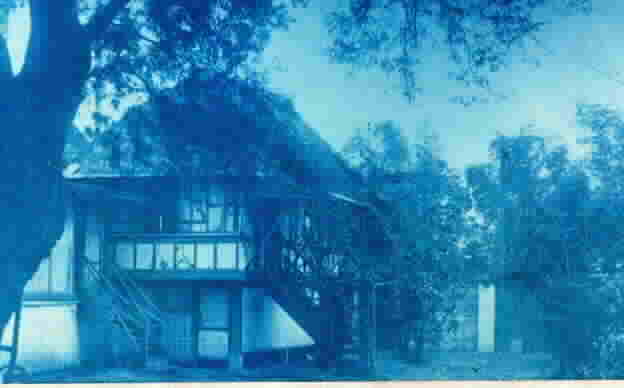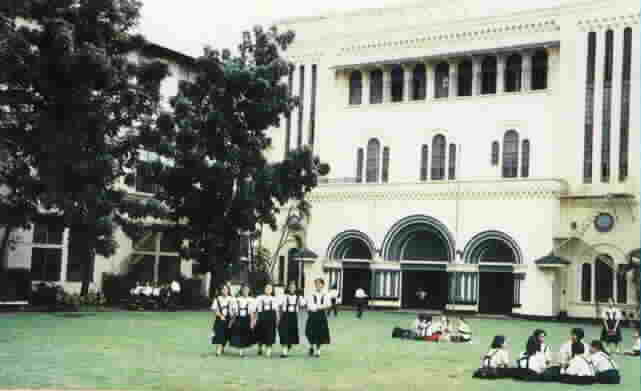St. Scholastica's College was founded on
December 3, 1906 in a small residential house in Tondo by Mother Fernanda,
OSB, and her four companions. They started with six paying students and
fifty in
the free section, but the next year
they had to move to San Marcelino for more space to house a highschool
department and some student boarders.
Christmas eve brought St. Scholastica's
first officially designated Directress, Sister Willibaida. Trained in England,
she guided the school for the next thirty years. She and her co-laborers
set high
Scholastican standards that gave
the young school the reputation for excellence.
The Conservatory of Music was opened
in 1907 under Sister Baptista Battig, a famed concert artist before her
convent days, who pioneered the first formal music education in this country.
In 1914, the school moved to a much larger area in Singalong, its
present site. Foreseeing the need for advanced education for women the
Sisters obtained government permission to operate an institution for higher
learning, and in 1923 graduated their
first college students.
In subsequent years course offerings increased
and the physical plant
expanded. When the Board of Educational
Survey confirmed the
report of the Educational Survey
Commission of 1925, it named St.
Scholastica's College one of two
schools representative of those
maintaining "the highest standards
with reference to physical plant,
equipment, teaching personnel, and
methods of instruction."
World War 11 razed St. Scholastica's
school buildings but not her
spirit. The war's end in 1945 meant
a new beginning. Today, St.
Scholastica's College offers education
from prep through college. In
September 1957, the College Unit
was accredited by the Philippine
Accrediting Association of Schools.
Colleges and Universities. At the
same time, St. Scholastica's College
became a charter member of the
said association. Re-accreditation
was earned by the College in 1960,
1967, 1974, 1981, 1987 and 1994.
The High School Department has
been accredited since 1964, the Grade
School since 1973.
 From the start, St. Scholastica's
College has striven for academic excellence as part of her idea of service
to God and the Filipino people. As an instrument of the Church, she has
accepted theChurch's mission of liberation of all peoples from all forms
of injustice and oppression. She acquaints the members of her community
With the many local, national and international situations as well as structures
that breed and perpetuate them. Recognition of current reality has led
the school to direct her academic and non-academic programs towards
a greater sensitivity to social justice through systematic study, exposure
and involvement.
In 1975, the College made a definite
thrust for social justice in adopting the theme of "Education for Justice."
Its curriculum, methodology and co-curricular activities were re-oriented
towards
social awareness and commitment of
the whole academic community. For this purpose the Social Development and
Community Organizing Program was introduced. Within the College grounds
is a Social Action Center serving the urban poor not only in the Singalong
area but also in the outreach areas.
From the start, St. Scholastica's
College has striven for academic excellence as part of her idea of service
to God and the Filipino people. As an instrument of the Church, she has
accepted theChurch's mission of liberation of all peoples from all forms
of injustice and oppression. She acquaints the members of her community
With the many local, national and international situations as well as structures
that breed and perpetuate them. Recognition of current reality has led
the school to direct her academic and non-academic programs towards
a greater sensitivity to social justice through systematic study, exposure
and involvement.
In 1975, the College made a definite
thrust for social justice in adopting the theme of "Education for Justice."
Its curriculum, methodology and co-curricular activities were re-oriented
towards
social awareness and commitment of
the whole academic community. For this purpose the Social Development and
Community Organizing Program was introduced. Within the College grounds
is a Social Action Center serving the urban poor not only in the Singalong
area but also in the outreach areas.
|
In 1985, celebrating its tenth year of social
orientation, the College initiated the Women's Studies Program, which is
a deepening and logical development of its orientation towards
social transformation. Women active in the women's movement came
together to v4ork out
the orientation, objectives and syllabus
of an introductory course on Women's Studies. This program
developed into the Institute of Women's Studies, which is an
affiliate body of St. Scholastica's College. It aims at awakening consciousness
and providing understanding of the Woman question through formal institutional
educational strategy, research and studies pertaining to gender issues;
initiation and administration of projects promoting the cause of
women; and provision of outreach
programs to serve women outside
the formal educational institution.
Through the years the school has
adopted various themes appropriate
to the contemporary environment:
1975-1976
Sense of Commitment
1976-1977
Community Building
1977-1978
Social Awareness
1978-1979
Socially Oriented School
1979-1980
Social Involvement
1980-1985
Education for Justice
1986-1987
The Self-Awareness of the Filipino Woman
1987-1988
Women and Environment
One Bread, One Body, One People Shelter for the
Homeless
1988-1989
Women in National Development Mary of the
Magnificat Peace and Disarmament
1989-1990
Justice, Peace and Integrity of Creation
1990-1991
Peace and Sovereignty
1991-1992
Solidarity and Ecumenism
1993-1995
Evangelized and Evangelizing Community, Academic
Excellence as Social Responsibility
1995-1998
Benedictine Values for Evangelization, Academic
Excellence as Social Responsibility
 The school can boast of a Financial
Assistance Program which provides study grants on a socialized basis to
deserving students who qualify for admission to the Grade School, High
School and College.
In addition, SSC provides formal
education to young women who cannot enroll in a regular high school through
the Night Secondary School. The Night Secondary School students use the
classrooms and facilities of the High School. Some of the teachers in the
day school make it their apostolate to teach in the Night Secondary School.
Thus, SERVICE is the axis of the
heritage, commitment, and vision of St. Scholastica's College in educating
the youth. St. Scholastica's College has sustained a deep loyalty to the
Benedictine ideals of ORA ET LABORA set down by Holy Father Benedict. The
spirit of ORA ET LABORA vivifies her work, rendering it adaptable at all
times, places and circumstances. It directs her life and activity towards
one if aim which is St. Benedict's - THAT IN ALL THINGS GOD MAY BE GLORIFIED.
The school can boast of a Financial
Assistance Program which provides study grants on a socialized basis to
deserving students who qualify for admission to the Grade School, High
School and College.
In addition, SSC provides formal
education to young women who cannot enroll in a regular high school through
the Night Secondary School. The Night Secondary School students use the
classrooms and facilities of the High School. Some of the teachers in the
day school make it their apostolate to teach in the Night Secondary School.
Thus, SERVICE is the axis of the
heritage, commitment, and vision of St. Scholastica's College in educating
the youth. St. Scholastica's College has sustained a deep loyalty to the
Benedictine ideals of ORA ET LABORA set down by Holy Father Benedict. The
spirit of ORA ET LABORA vivifies her work, rendering it adaptable at all
times, places and circumstances. It directs her life and activity towards
one if aim which is St. Benedict's - THAT IN ALL THINGS GOD MAY BE GLORIFIED.
|

